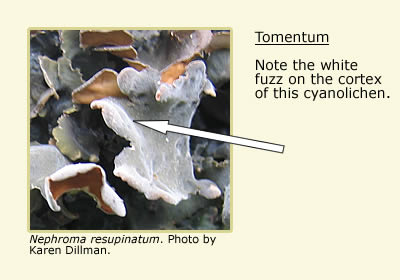USDA Forest Service Celebrating Wildflowers
|
|
|
 |
|
Lichens GlossaryLichenologists use many unique terms to describe the structure and biology of lichens. Although we keep the lichen jargon to a minimum, there are some commonly used terms that you will see when looking at other lichen websites or books, as well as some used here. apothecia - the most common sexual reproduction structure of the lichen’s fungal partner, it is cup-shaped or disc-shaped and produces spores.
cephalodia - little pockets of cyanobacteria that form on top of a chlorolichen, normally black in color.
chlorolichen - a lichen that has a green alga for its photobiont.
cilia - little hairs on the margin of a lichen; for example, black hairs on the margins of a foliose lichen.
cyanolichen - a lichen that has cyanobacteria for its primary photobiont.
hyphae (hypha) - the filamentous strands of fungal cells that make up the thallus of a lichen; they encapsulate the algal cells. isidia - a vegetative means of propagation for lichens; normally found on the top-side or outer cortex of the lichen; both fungal and algal cells are combined in a column-like structure that can break off and establish elsewhere.
lichenized - a fungus, alga, or cyanobacterium that is in a lichen partnership. lobe - a flattened branch, generally found on foliose lichens.
lobule - a vegetative means of propagation for lichens; small lobe-like two-sided propagules that break off and reestablish elsewhere. macrolichen - a foliose or fruticose lichen; physical features are seen with the naked eye.
microlichen - a crustose or squamulose lichen; physical features are difficult to see with a naked eye and a microscope is required for identification. mycobiont - the fungal partner of a lichen. photobiont - the photosynthetic partner of a lichen. soredia (soralia) - a vegetative means of propagation for lichens. Both fungus and alga are intertwined into a granule-like mass that occurs on top of the cortex and on the margins. Some lichens have structures called soralia that produce soredia.
spore - in lichens, produced by the mycobiont only for sexual reproduction; a tiny uni- or multi-cellular structure that gives rise to another fungus; no photobiont is included within the spore.
squamules (squamulose) - small foliose lichen structures that are attached to their substrate by one end, like a shingle; several of these structures will comprise a lichen.
symbiosis - a relationship between two or more organisms in which at least one organism benefits from the other. thallus (thalli) - the vegetative body of the lichen, composed of both fungus and alga. tomentum (tomentose) - colorless hyphae that look like short fuzz or hairs on the outside of the lichen.
|
|
| NOTE: PDF format links require the Adobe Acrobat Reader to view. | |
| top | Disclaimers | FOIA | Privacy Policy | Quality of Information | Photo Credits & Use |
Location: http://www.fs.fed.us/wildflowers/interesting/lichens/glossary.shtml
Last modified: Tuesday, 24-Jun-2008 21:54:35 EDT











